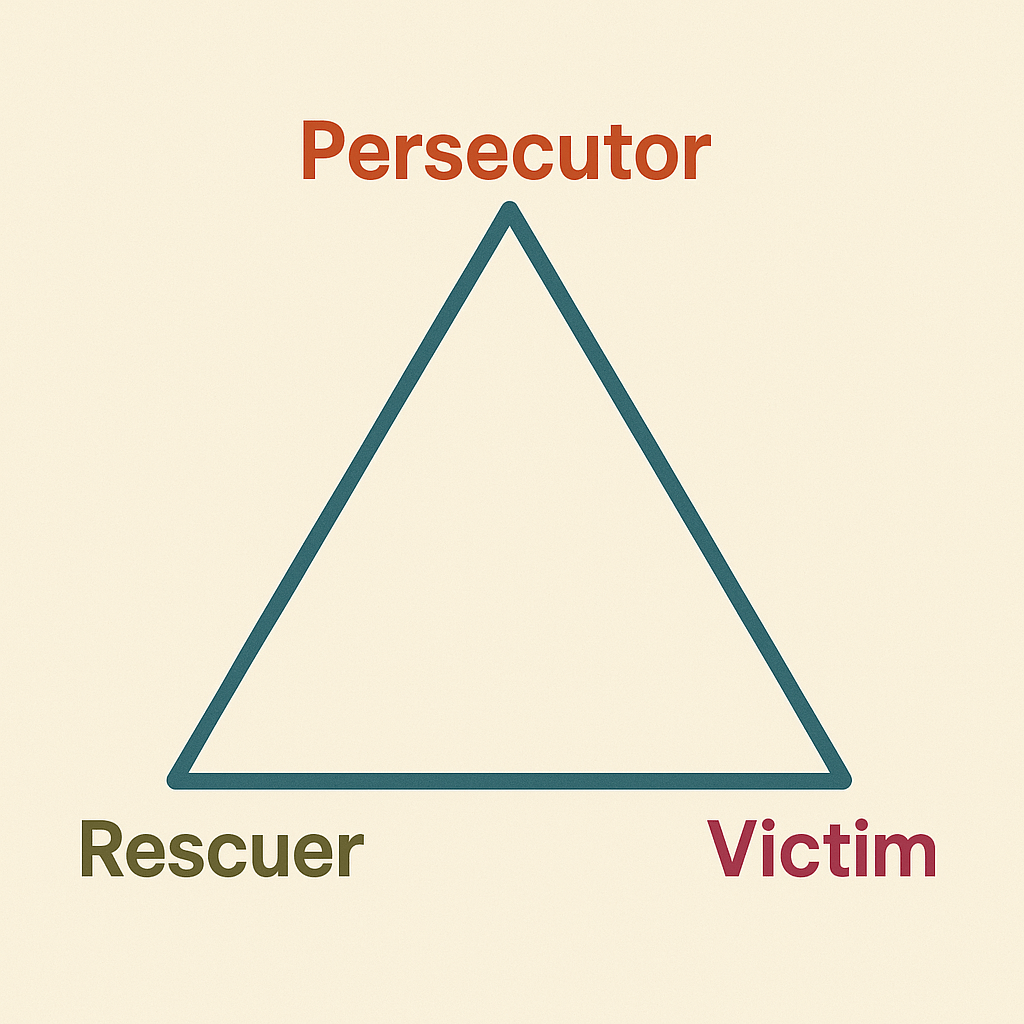Introduced by Dr. Stephen Karpman in 1968, the Drama Triangle is a psychological model that outlines a dysfunctional, repeating pattern of interpersonal conflict. In this pattern, people unconsciously adopt one of three roles: Victim, Persecutor, and Rescuer, each of which perpetuates the cycle of conflict and prevents resolution.
Karpman’s idea was that conflict often persists because people are unaware of the roles they are playing or how these roles perpetuate the cycle. It is important to note that these “roles” are not fixed personality types, but patterns which people can slip into, and they can sometimes even shift between them.
The model is used in psychology, counseling, and organizational training to help people recognize unhelpful behavior patterns and move toward healthier communication.
The three roles in the Drama Triangle

The Drama Triangle doesn’t require all three roles to be present at once, and it can apply to any type of interpersonal relationship, or conflict between people.
Two people can sustain the cycle by switching between roles, and one person can play all three roles internally when dealing with their own problems. The dynamic is driven by the underlying mindset of each role: feeling powerless (Victim), justified in blame (Persecutor), or compelled to “fix” (Rescuer).
1. Victim
In this role, a person feels helpless, powerless, and/or oppressed. They take on a passive approach by believing things are happening to them and that they have no influence or choice. While their suffering may be real, the Victim stance keeps them from problem-solving or taking any constructive action.
Example: a Victim constantly complains about their workload in the office, saying there is “nothing they can do” because their boss is unreasonable, yet they avoid discussing this with the boss or searching for a solution.
Role shift: over time, a Victim’s bottled frustration can escalate, and they might start to snap, blaming others for not helping them or blaming their co-workers for their own mistakes. In this case, their role shifts into one of a Persecutor.
2. Persecutor
This role has a very dominant stance. People in this role maintain a sense of superiority by making others feel inadequate. They usually assign blame, criticize, and rarely foster solutions.
Example: a Persecutor parent constantly criticizes their child’s work, justifying it by saying they are “motivating” them to succeed.
Role shift: a child may grow up to become a Persecutor, giving the parent the same treatment they received, where the parent shifts into the role of a Victim. Another shift of the role could happen if a child goes through an emotional breakdown, and overwhelmed by guilt, the parent becomes a Rescuer who overcompensates for the harm caused.
3. Rescuer
People in this role try to “save” others, often without being asked to. They tend to lose sight of themselves and their issues in trying to help others. Although this may seem kind on the surface, in some situations it can be damaging as it can reinforce a Victim’s behavioral patterns.
Example: Rescuers in the relationship usually take the “I will handle everything” approach, such as planning and paying for everything all the time or trying to “fix” their partner who might be struggling with mental health issues.
Role shift: in this example, a Rescuer might shift into the role of a Persecutor if they feel like all the responsibilities are on them and begin to despise other people in the relationship. On the other hand, they can also become a Victim if they feel underappreciated or powerless, and believe they are “getting nothing in return” for example.
A way out of the Triangle
Stepping out of the Drama Triangle means choosing differently: offering support without rescuing, caring without enabling, respecting boundaries without controlling, and acknowledging vulnerabilities without giving up personal responsibility.
One useful framework for this is called The Empowerment Dynamic (TED), introduced by David Emerald. It reframes three Drama Triangle roles into more constructive ones:
- A Victim becomes a Creator – focusing on coming up with solutions and desired outcomes. For example, “This is impossible” becomes “What’s the next step I can take to make progress?”
- A Rescuer becomes a Coach – offering support that builds capability instead of dependency. For example, “I’ll just do it for you” becomes “What resources or ideas might help you move forward?”
- A Persecutor becomes a Challenger – promoting growth through constructive feedback. For example, “You should’ve done that better, it’s your fault,” becomes “What issues have you encountered and how can we solve them together?”